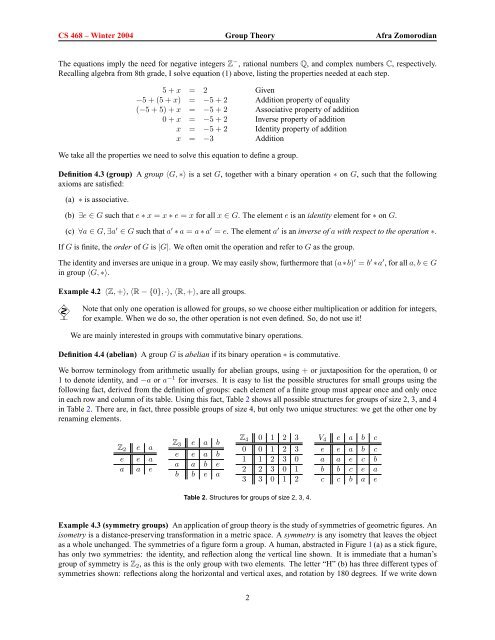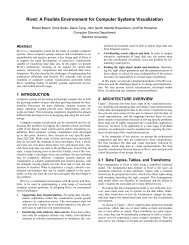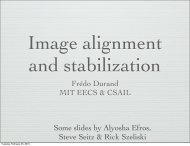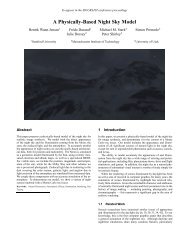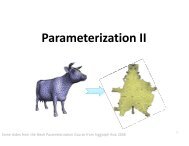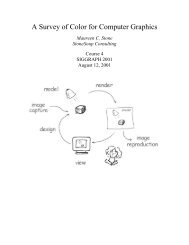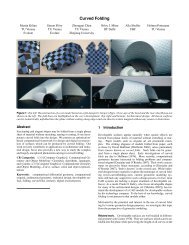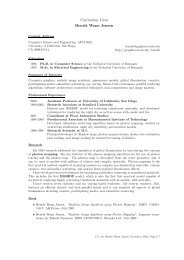Topology for Computing Mini-Kurse pdfsubject - Computer Graphics ...
Topology for Computing Mini-Kurse pdfsubject - Computer Graphics ...
Topology for Computing Mini-Kurse pdfsubject - Computer Graphics ...
Create successful ePaper yourself
Turn your PDF publications into a flip-book with our unique Google optimized e-Paper software.
CS 468 – Winter 2004 Group Theory Afra Zomorodian<br />
The equations imply the need <strong>for</strong> negative integers Z − , rational numbers Q, and complex numbers C, respectively.<br />
Recalling algebra from 8th grade, I solve equation (1) above, listing the properties needed at each step.<br />
5 + x = 2 Given<br />
−5 + (5 + x) = −5 + 2 Addition property of equality<br />
(−5 + 5) + x = −5 + 2 Associative property of addition<br />
0 + x = −5 + 2 Inverse property of addition<br />
x = −5 + 2 Identity property of addition<br />
x = −3 Addition<br />
We take all the properties we need to solve this equation to define a group.<br />
Definition 4.3 (group) A group 〈G, ∗〉 is a set G, together with a binary operation ∗ on G, such that the following<br />
axioms are satisfied:<br />
(a) ∗ is associative.<br />
(b) ∃e ∈ G such that e ∗ x = x ∗ e = x <strong>for</strong> all x ∈ G. The element e is an identity element <strong>for</strong> ∗ on G.<br />
(c) ∀a ∈ G, ∃a ′ ∈ G such that a ′ ∗ a = a ∗ a ′ = e. The element a ′ is an inverse of a with respect to the operation ∗.<br />
If G is finite, the order of G is |G|. We often omit the operation and refer to G as the group.<br />
The identity and inverses are unique in a group. We may easily show, furthermore that (a∗b) ′ = b ′ ∗a ′ , <strong>for</strong> all a, b ∈ G<br />
in group 〈G, ∗〉.<br />
Example 4.2 〈Z, +〉, 〈R − {0}, ·〉, 〈R, +〉, are all groups.<br />
� Note that only one operation is allowed <strong>for</strong> groups, so we choose either multiplication or addition <strong>for</strong> integers,<br />
<strong>for</strong> example. When we do so, the other operation is not even defined. So, do not use it!<br />
We are mainly interested in groups with commutative binary operations.<br />
Definition 4.4 (abelian) A group G is abelian if its binary operation ∗ is commutative.<br />
We borrow terminology from arithmetic usually <strong>for</strong> abelian groups, using + or juxtaposition <strong>for</strong> the operation, 0 or<br />
1 to denote identity, and −a or a −1 <strong>for</strong> inverses. It is easy to list the possible structures <strong>for</strong> small groups using the<br />
following fact, derived from the definition of groups: each element of a finite group must appear once and only once<br />
in each row and column of its table. Using this fact, Table 2 shows all possible structures <strong>for</strong> groups of size 2, 3, and 4<br />
in Table 2. There are, in fact, three possible groups of size 4, but only two unique structures: we get the other one by<br />
renaming elements.<br />
Z2 e a<br />
e e a<br />
a a e<br />
Z3 e a b<br />
e e a b<br />
a a b e<br />
b b e a<br />
Z4 0 1 2 3<br />
0 0 1 2 3<br />
1 1 2 3 0<br />
2 2 3 0 1<br />
3 3 0 1 2<br />
Table 2. Structures <strong>for</strong> groups of size 2, 3, 4.<br />
V4 e a b c<br />
e e a b c<br />
a a e c b<br />
b b c e a<br />
c c b a e<br />
Example 4.3 (symmetry groups) An application of group theory is the study of symmetries of geometric figures. An<br />
isometry is a distance-preserving trans<strong>for</strong>mation in a metric space. A symmetry is any isometry that leaves the object<br />
as a whole unchanged. The symmetries of a figure <strong>for</strong>m a group. A human, abstracted in Figure 1 (a) as a stick figure,<br />
has only two symmetries: the identity, and reflection along the vertical line shown. It is immediate that a human’s<br />
group of symmetry is Z2, as this is the only group with two elements. The letter “H” (b) has three different types of<br />
symmetries shown: reflections along the horizontal and vertical axes, and rotation by 180 degrees. If we write down<br />
2


